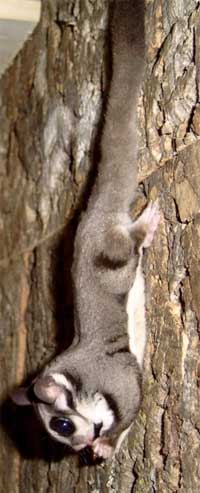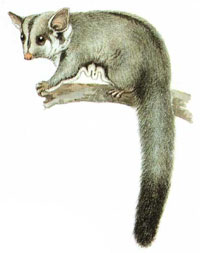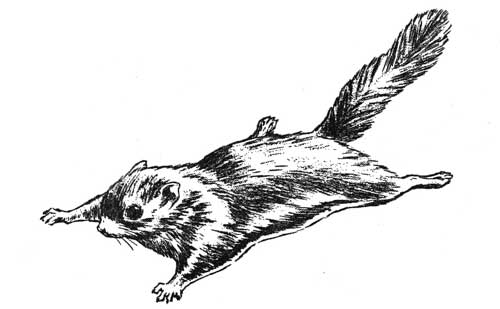|

The Flying Sugar: The Sugar glider (Petaurus breviceps), sometimes called the Flying Sugar, is a small gliding possum native to eastern and northern mainland Australia, New Guinea, and the Bismarck Archipelago, and introduced to Tasmania.
 Weights and Measures: The Sugar Glider is around 16 to 20 cm (6.3 to 7.5 in) in length, with a tail almost as long as the body, and weigh between 90 and 150 grams (3 to 5.3 oz). Weights and Measures: The Sugar Glider is around 16 to 20 cm (6.3 to 7.5 in) in length, with a tail almost as long as the body, and weigh between 90 and 150 grams (3 to 5.3 oz).
Grey, Cream, Black: The fur is generally pearl gray, with black and cream patches at the base of the black or gray ears. Other color variations include leucistic and albino recessive traits. The tail tapers only moderately and the last quarter of it is black, often with a dark tip. The muzzle is short and rounded. Northern forms tend to be brown colored rather than gray and, as predicted by Bergmann's Rule, smaller.
Flaps for Gliding: The most noticeable features of its anatomy, however, are the twin skin membranes called patagium which extend from the fifth finger of the forelimb back to the first toe of the hind foot.
Hidden Hang Glider: These are inconspicuous when the Sugar glider is at rest — it merely looks a little flabby, as though it had lost a lot of weight recently — but immediately obvious when it takes flight. The membranes are used to glide between trees: when fully extended they form an aerodynamic surface the size of a large handkerchief.
Gliding to Food and Safety: The gliding membranes are primarily used as an efficient way to get to food resources. They may also, as a secondary function, help the Sugar glider escape predators like goannas, introduced foxes and cats, and the marsupial carnivores that foxes, cats, and dingos largely supplanted.
 I Believe I Can Glide: The ability to glide from tree to tree is clearly of little value with regard to the Sugar glider's avian predators, however, in particular owls and kookaburras. I Believe I Can Glide: The ability to glide from tree to tree is clearly of little value with regard to the Sugar glider's avian predators, however, in particular owls and kookaburras.
50 Meter Dash: Although its aerial adaptation looks rather clumsy and primitive by comparison with the highly specialized limbs of birds and bats, the Sugar glider can glide for a surprisingly long distance — flights have been measured at over 50 meters (55 yd) — and steer effectively by curving one or other of the patagium.
It uses its hind legs to thrust powerfully away from a tree, and when about 3 meters (3 yd) from the destination tree trunk, brings its hind legs up close to the body and swoops upwards to make contact with all four limbs together.

Furry Features: Flying phalangers are typically nocturnal, most being small in size (sometimes around 400 mm, counting the tail), and have folds of loose skin running from the wrists to the ankles. They use this skin to glide from tree to tree by jumping and holding out their limbs spread-eagle. They're able to travel for distances as long as 100 meters. Beside the distinctive skin folds, flying phalangers also have large, forward facing eyes, short (though pointed faces), and long, flat tails which are used as rudders while gliding.
All are omnivores, and eat tree sap, gum, nectar, pollen, and insects, along with manna and honeydew. Most flying phalangers appear to be solitary, though the Yellow-bellied glider and Sugar glider are both known to live in groups.

All text is available under the terms
of the GNU Free Documentation License
|